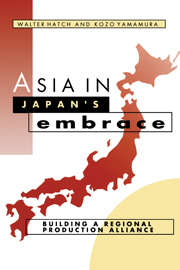Book contents
- Frontmatter
- Contents
- List of Tables
- List of Figures
- Preface
- Part One Co-Prosperity Again
- Part Two The Embracer and the Embraced
- Part Three A Japanese Alliance in Asia
- 7 The Visible Handshake
- 8 Vertical Veins of Humanity
- 9 The Labor Network
- 10 The Supply Network
- Part Four A Powerful Embrace
- Notes
- Select Bibliography
- Index
9 - The Labor Network
Published online by Cambridge University Press: 05 February 2012
- Frontmatter
- Contents
- List of Tables
- List of Figures
- Preface
- Part One Co-Prosperity Again
- Part Two The Embracer and the Embraced
- Part Three A Japanese Alliance in Asia
- 7 The Visible Handshake
- 8 Vertical Veins of Humanity
- 9 The Labor Network
- 10 The Supply Network
- Part Four A Powerful Embrace
- Notes
- Select Bibliography
- Index
Summary
It is 7:45 a.m. In Petaling Jaya, a suburb of Kuala Lumpur, 2,000 men and women wearing the light blue uniforms of Matsushita twist their torsos back and forth. Back and forth. After five minutes of calisthenics, they begin singing the company song and reciting – in Malay or English – the company creed. Then, before they finally knuckle down to the chore of assembling truckloads of air conditioners, the Matsushita workers break into small groups to discuss production issues with their supervisors.
While carefully choreographed in Japan, this daily ritual is performed with only minor variations on Matsushita shopfloors all over the world. Here in Petaling Jaya, for example, a revised version of the company song exhorts employees to not only “produce forever general appliances for the people,” but also to “create a new Malaysia.” And in the morning meetings, any mention of race, religion, or politics – all potentially volatile topics in this heterogeneous society – is strictly prohibited. Otherwise, a Matsushita employee's day in Malaysia proceeds like a Matsushita employee's day in Japan.
This is, of course, no accident. The company is firmly committed to a paternalistic employment system that has demonstrated its ability to increase productivity over time. And Matsushita is not alone. As they have expanded beyond Japan to set up plants all over the globe, other large manufacturers have tried to replicate a distinctively “Japanese” style of management. Karatsu Hajime, a Japanese professor of technology development, says Japan's overseas production facilities are “mini-Japans.”
- Type
- Chapter
- Information
- Asia in Japan's EmbraceBuilding a Regional Production Alliance, pp. 146 - 157Publisher: Cambridge University PressPrint publication year: 1996

